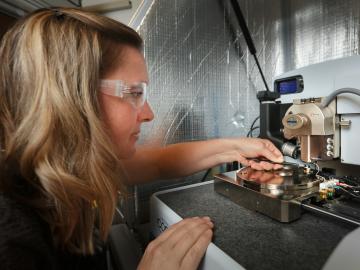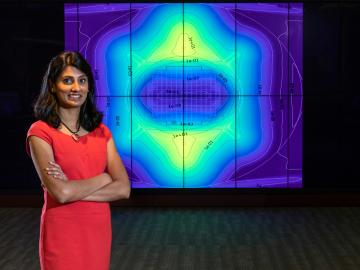
Filter News
Area of Research
- Advanced Manufacturing (4)
- Biology and Environment (3)
- Building Technologies (1)
- Clean Energy (32)
- Climate and Environmental Systems (1)
- Computational Engineering (1)
- Computer Science (6)
- Fusion Energy (4)
- Materials (23)
- National Security (2)
- Neutron Science (9)
- Nuclear Science and Technology (9)
- Quantum information Science (2)
- Supercomputing (8)
- Transportation Systems (1)
News Type
Date
News Topics
- 3-D Printing/Advanced Manufacturing (9)
- Advanced Reactors (6)
- Artificial Intelligence (5)
- Big Data (5)
- Bioenergy (1)
- Biomedical (1)
- Clean Water (3)
- Composites (1)
- Computer Science (16)
- Cybersecurity (1)
- Energy Storage (4)
- Environment (9)
- Fusion (3)
- Grid (4)
- Machine Learning (3)
- Materials Science (12)
- Mercury (1)
- Microscopy (3)
- Molten Salt (1)
- Nanotechnology (3)
- Neutron Science (8)
- Nuclear Energy (12)
- Physics (3)
- Polymers (2)
- Quantum Science (3)
- Space Exploration (3)
- Summit (2)
- Sustainable Energy (2)
- Transportation (9)
Media Contacts

As a computational hydrologist at Oak Ridge National Laboratory, Ethan Coon combines his talent for math with his love of coding to solve big science questions about water quality, water availability for energy production, climate change, and the

In collaboration with the Department of Veterans Affairs, a team at Oak Ridge National Laboratory has expanded a VA-developed predictive computing model to identify veterans at risk of suicide and sped it up to run 300 times faster, a gain that could profoundly affect the VA’s ability to reach susceptible veterans quickly.

Researchers at Oak Ridge National Laboratory proved that a certain class of ionic liquids, when mixed with commercially available oils, can make gears run more efficiently with less noise and better durability.

Researchers used neutron scattering at Oak Ridge National Laboratory’s Spallation Neutron Source to probe the structure of a colorful new material that may pave the way for improved sensors and vivid displays.

A team including Oak Ridge National Laboratory and University of Tennessee researchers demonstrated a novel 3D printing approach called Z-pinning that can increase the material’s strength and toughness by more than three and a half times compared to conventional additive manufacturing processes.

Ask Tyler Gerczak to find a negative in working at the Department of Energy’s Oak Ridge National Laboratory, and his only complaint is the summer weather. It is not as forgiving as the summers in Pulaski, Wisconsin, his hometown.

When Nina Balke came to the United States on a Feodor Lynen Fellowship for German scholars, her original plan was to complete a year abroad and return home to native opportunities in materials sciences.

Isabelle Snyder calls faults as she sees them, whether it’s modeling operations for the nation’s power grid or officiating at the US Open Tennis Championships.

Like many soon-to-be high school seniors, Eva Davidson thought she knew what she wanted to be and how to get there. A chance encounter at a college fair altered that path—a change in plans she has never regretted.

Oak Ridge National Laboratory is training next-generation cameras called dynamic vision sensors, or DVS, to interpret live information—a capability that has applications in robotics and could improve autonomous vehicle sensing.


